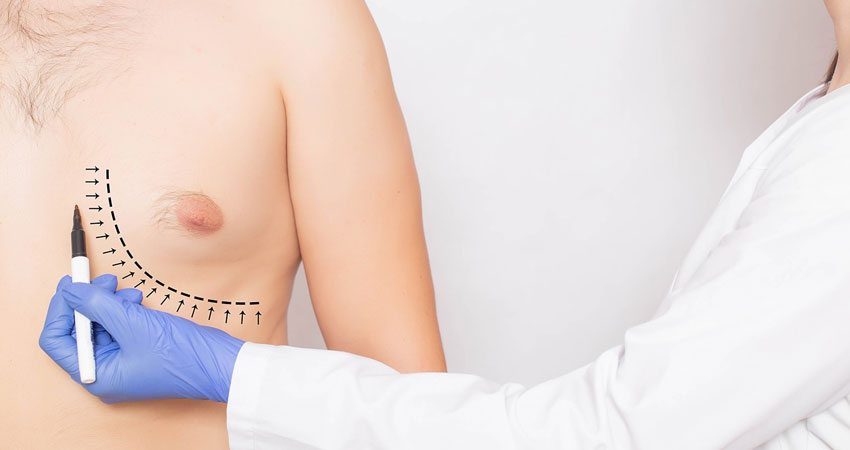
Male Breast Reduction
Gynaecomastia is an enlargement of the male breast as a result of an abnormal increase in the breast glandular tissue. It affects a significant percentage of the male population, to differing degrees. Gynaecomastia correction is usually best carried out on patients who have reasonably elastic skin, which will contract and mould to the new contour. This procedure is not a way of losing weight. Gynaecomastia can be corrected either by liposuction or by doing a surgical procedure- Breast Reduction.
Causes
Most teenage boys experience some degree of breast enlargement affecting one or both breasts. However, by early adulthood less than 10% have a residual problem. This incidence rises with age, reaching approximately 30% (1 in 3) in older men. Rarely, the breast enlargement can be caused by medicines (for high blood pressure, heart disease and prostate cancer), drugs (such as marijuana and anabolic steroids), some diseases (such as liver failure and some cancers) and some very rare congenital abnormalities (errors of development that one is born with). These causes should be excluded by the surgeon during an initial consultation.
The Operation
The breast is made up of two main components, glandular tissue (firm and dense) and fatty tissue (soft). The ratio of glandular to fatty tissue in any breast varies from individual to individual and in gynaecomastia there may be an excess of both. If there is predominantly a diffuse fatty enlargement of the breast, liposuction is the usual treatment. This involves sucking out the tissue through a small tube inserted via a 3-4mm incision (see information sheet on liposuction for more detail). If excess glandular tissue is the primary cause of breast enlargement, it may need to be excised (cut out) with a scalpel during open surgery. Male breast reduction is performed to reduce the size of the breasts, by removing abnormal fat, and breast tissue, in order to achieve a more natural contour to the male chest. This is a surgical procedure, carried out under a general anaesthetic, requiring an overnight stay in hospital. You will also need to plan some time off work, to rest, after the surgery and your discharge from the hospital. This will leave a scar, usually around the nipple edge. This excision can be performed alone or in conjunction with liposuction. Major reductions that involve the removal of a significant amount of tissue and skin may require larger incisions that result in more obvious scars.
After The Surgery
Following the surgery the chest is swollen and bruised for a while and it can be difficult to assess the full effect of the operation. To help reduce swelling, patients are often instructed to wear an elastic pressure garment continuously for one or two weeks. It is advisable to refrain from exercise for about three weeks and, in general, it takes about four weeks before one can return to completely normal activities. The potential complications of the surgery are relatively rare. They include bleeding, infection, scarring, inadequate removal of breast tissue, an uneven contour to the chest and reduced nipple sensation. If an excision has been performed, rather than liposuction, then a blood clot can form that may need to be drained at a second operation.
Post Op Instruction
Following your operation (open surgery), you will have a small drainage tube in each breast. This collects any leakage of blood into the bottles, to which they are attached. These are usually removed after 24hrs, depending on the amount of drainage.
It is advisable to sleep sitting a little upright for the first 48-72 hours, to reduce the amount of swelling present.
Following your surgery, you will be advised to wear a pressure garment, for a period of 4 weeks, to reduce the swelling post operatively.
There will always be scars following the open surgery; these may be more noticeable in the first 3-6 months after surgery, and fade over 18 months.
Do not lift anything heavy, for 14 days post surgery, to give the tissues time to heal.
Try to avoid getting the dressings wet.
Do take your medications as prescribed. (Antibiotics and analgesics).
Bruising is a natural result of the surgery, and may persist for a while. Hardness and or lumpiness within the tissues, due to swelling, may persist, for a couple of weeks.
No sporting activity for 4 weeks post surgery, so as not to put any strain on your wounds, but you may return to work after 2 weeks.
You will be asked to massage the scar lines with a special scar cream, firmly, three times a day, to help the scars to settle over a period of time.
Phone and arrange to see the doctor if you are concerned, or if you have any of the following
1. Fever
2. Visible swelling over the breasts
3. The breasts become hard, hot or reddened in colour
4. Excessive pain
 WhatsApp
WhatsApp